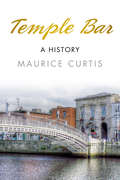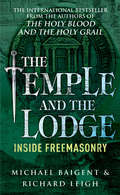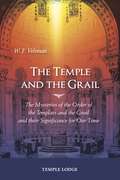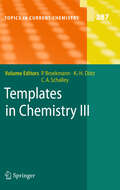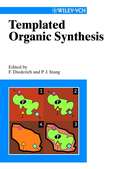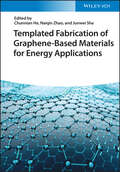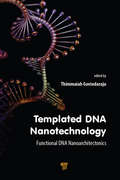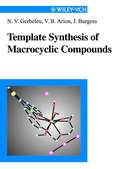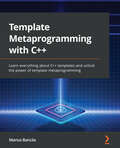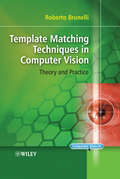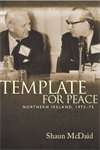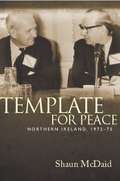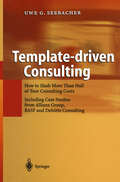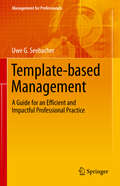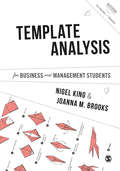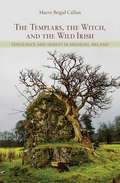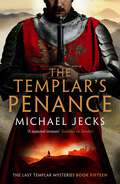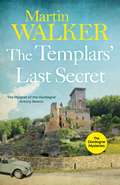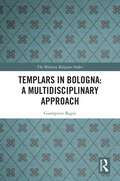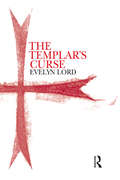- Table View
- List View
Temple Bar: A History
by Maurice CurtisFor as long as we have records, Temple Bar has been at the heart of Dublin’s cultural life. Its history is one of design, craft, publishing, the performing arts, coffee houses, political debate and great colour and energy. The world’s favourite oratorio and chorus – ‘Hallelujah’ from Handel’s Messiah – had its world premiere in Temple Bar in 1742 in Neals’ Musick Hall, and a tradition of great musical vibrancy has continued there over time. Today, it is one of the central tourist areas of Dublin, and one of the most visited sets of streets on the island of Ireland. This is its history.
The Temple And The Lodge: The Strange And Fascinating History Of The Knights Templar And The Freemasons
by Michael Baigent Richard LeighIn this enthralling historical detective story, the authors of The Holy Blood and the Holy Grail trace the flight after 1309 of the Knights Templar from Europe to Scotland, where the Templar heritage was to take root, and would be perpetuated by a network of noble families. That heritage, and the Freemasonry that arose from it, became inseparable from the Stuart cause. The Temple and the Lodge charts the birth of Freemasonry through the survival of Templar traditions, through currents of European thought, through the mystery surrounding Rosslyn chapel, and through an elite cadre of aristocrats attached as personal bodyguards to the French king. Pursuing Freemasonry through the 17th and 18th Centuries, Michael Baigent and Richard Leigh reveal its contribution to the fostering of tolerance, progressive values, and cohesion in English society, which helped to pre-empt a French-style revolution. Even more dramatically, the influence of Freemasonry emerges as key facto in the formation of the United States of America as an embodiment of the ideal 'Masonic Republic'.
The Temple and the Grail: The Mysteries of the Order of the Templars and the Grail and their Significance for Our Time
by W. F. VeltmanIn the popular imagination, the Holy Grail – part of the legendary romance of King Arthur – belongs to the realm of myth. The Knights Templar also have a legendary, enigmatic aspect. Despite the immense volume of historical research available, plausible explanations to the ‘mystery’ at the core of their practices have yet to be revealed.By studying these two themes side-by-side and showing their inner relationship, Veltman reveals valuable new perspectives. On the one hand he demonstrates that the ‘poetic imagination’ of the Grail mystery has its origin in concrete historical events; and on the other hand, that the true history of the Knights Templar is, essentially, esoteric.Combining historical research with insights gained from the work of Rudolf Steiner, Veltman presents an impressive survey of the subject, beginning with the pre-Christian Mysteries and ending with a vision of Michaelic Christianity. He analyses the significance of the holy city of Jerusalem, the Temple of Solomon, the Temple Legend, the Grail Temple, the Rosicrucians, the Templars’ gold, and the fraught question of evil. In addition, he sketches the continuation or metamorpho¬sis of the Grail and Temple impulses into the future, including the critical ‘balancing’ role of Europe between East and West. To become effective, this important European task – which, he says, is continually being thwarted – must be properly understood within the realm of human consciousness.
Templates in Chemistry III (Topics in Current Chemistry #287)
by Peter Broekmann Karl Heinz Dötz Christoph A. SchalleyTemplated Organic Synthesis
by François Diederich Peter J. StangTemplate-controlled reactions allow the synthesis of complex molecules which would hardly be achievable through classical methods. This handbook offers authoratative information on how noncovalent and covalent templates can be effectively applied to control reaction rates as well as regio- and stereoselectivity. From the concepts of template control such as molecular imprinting, self-replication, and reversible tether-directed remote functionalization, the reader is led to template-based ring-closing reactions, oligomerizations, and multiple functionalizations and their application in the synthesis of supramolecular scaffolds and natural products. The editors and authors (J. F. Stoddart, G. Wulf, D. Lynn, R. Breslow. F. Diederich, just to name a few ) , all internationally recognized experts in their area, succeeded in presenting the manifold aspects of template-controlled synthesis in a didactic way, making this methodology accessible to a broad readership of organic synthetic chemists. Well-selected, reliable key experimental protocols and an up-to-date reference list underline the practical approach of this valuable handbook. Being the first book of its kind, it will serve as a pacemaker and stimulate future research.
Templated Fabrication of Graphene-Based Materials for Energy Applications
by Chunnian He Naiqin Zhao Junwei ShaTemplated Fabrication of Graphene-Based aterials for Energy Applications An illuminating look at the latest research on graphene-based materials and their applications in energy In Templated Fabrication of Graphene-Based Materials for Energy Applications, a team of distinguished materials scientists delivers a unique and topical exploration of a versatile fabrication method used to create high-quality graphene and composites. The book offers a three-part approach to current topics in graphene fabrication. The first part introduces graphene-based materials and is followed by cutting-edge discussions of template methods used in the preparation of graphene-based materials. The editors conclude with the latest research in the area of graphene-based materials applications in various energy-related pursuits. Readers will find relevant content that refers to original research conducted by the editors themselves, as well as work from up-and-coming and established researchers that explores the most interesting horizons in the study of graphene-based materials. The book also provides: A thorough introduction to graphene, including its history and physical properties An in-depth analysis of current graphene synthesis strategies, including the classification of graphene preparations Expansive discussions of various kinds of template methods for graphene production, including the study of porous metals and the preparation of graphene in large quantities Comprehensive explorations of the applications of various graphene-based materials, including lithium-ion batteries, lithium-sulfur batteries, and supercapacitors Perfect for materials scientists, electrochemists, and solid-state physicists, Templated Fabrication of Graphene-Based Materials for Energy Applications will also earn a place in the libraries of physical chemists and professionals in the electrotechnical industry.
Templated Fabrication of Graphene-Based Materials for Energy Applications
by Chunnian He Naiqin Zhao Junwei ShaTemplated Fabrication of Graphene-Based aterials for Energy Applications An illuminating look at the latest research on graphene-based materials and their applications in energy In Templated Fabrication of Graphene-Based Materials for Energy Applications, a team of distinguished materials scientists delivers a unique and topical exploration of a versatile fabrication method used to create high-quality graphene and composites. The book offers a three-part approach to current topics in graphene fabrication. The first part introduces graphene-based materials and is followed by cutting-edge discussions of template methods used in the preparation of graphene-based materials. The editors conclude with the latest research in the area of graphene-based materials applications in various energy-related pursuits. Readers will find relevant content that refers to original research conducted by the editors themselves, as well as work from up-and-coming and established researchers that explores the most interesting horizons in the study of graphene-based materials. The book also provides: A thorough introduction to graphene, including its history and physical properties An in-depth analysis of current graphene synthesis strategies, including the classification of graphene preparations Expansive discussions of various kinds of template methods for graphene production, including the study of porous metals and the preparation of graphene in large quantities Comprehensive explorations of the applications of various graphene-based materials, including lithium-ion batteries, lithium-sulfur batteries, and supercapacitors Perfect for materials scientists, electrochemists, and solid-state physicists, Templated Fabrication of Graphene-Based Materials for Energy Applications will also earn a place in the libraries of physical chemists and professionals in the electrotechnical industry.
Templated DNA Nanotechnology: Functional DNA Nanoarchitectonics
by Thimmaiah GovindarajuNucleic acids have structurally evolved over billions of years to effectively store and transfer genetic information. In the 1980s, Nadrian Seeman’s idea of constructing a 3D lattice from DNA led to utilizing DNA as nanomolecular building blocks to create emergent molecular systems and nanomaterial objects. This bottom-up approach to construct nanoscale architectures with DNA marked the beginning of a new field, DNA nanotechnology, contributing significantly to the broad area of nanoscience and nanotechnology. The molecular architectonics of small "designer" molecules and short DNA sequences through complementary binding interaction engenders well-defined functional nanoarchitectures with realistic applications in areas ranging from biology to materials science and is termed "DNA nanoarchitectonics." This book discusses novel approaches adapted by leading researchers from all over the world to create functional nucleic acid molecular systems and nanoarchitectures. Individual chapters contributed by active practitioners provide fundamental and advanced knowledge emanated from their own and others’ work. Each chapter includes numerous illustrations, historical perspectives, case studies and practical examples, critical discussions, and future prospects. This book can serve as a practical handbook or as a textbook for advanced undergraduate- and graduate-level students of nanotechnology and DNA nanotechnology, supramolecular chemistry, and nanoarchitectonics and researchers working on macromolecular science, nanotechnology, chemistry, biology, and medicine, especially those with an interest in sensors, biosensors, nanoswitches and nanodevices, diagnostics, drug delivery, and therapeutics.
Templated DNA Nanotechnology: Functional DNA Nanoarchitectonics
by Thimmaiah GovindarajuNucleic acids have structurally evolved over billions of years to effectively store and transfer genetic information. In the 1980s, Nadrian Seeman’s idea of constructing a 3D lattice from DNA led to utilizing DNA as nanomolecular building blocks to create emergent molecular systems and nanomaterial objects. This bottom-up approach to construct nanoscale architectures with DNA marked the beginning of a new field, DNA nanotechnology, contributing significantly to the broad area of nanoscience and nanotechnology. The molecular architectonics of small "designer" molecules and short DNA sequences through complementary binding interaction engenders well-defined functional nanoarchitectures with realistic applications in areas ranging from biology to materials science and is termed "DNA nanoarchitectonics." This book discusses novel approaches adapted by leading researchers from all over the world to create functional nucleic acid molecular systems and nanoarchitectures. Individual chapters contributed by active practitioners provide fundamental and advanced knowledge emanated from their own and others’ work. Each chapter includes numerous illustrations, historical perspectives, case studies and practical examples, critical discussions, and future prospects. This book can serve as a practical handbook or as a textbook for advanced undergraduate- and graduate-level students of nanotechnology and DNA nanotechnology, supramolecular chemistry, and nanoarchitectonics and researchers working on macromolecular science, nanotechnology, chemistry, biology, and medicine, especially those with an interest in sensors, biosensors, nanoswitches and nanodevices, diagnostics, drug delivery, and therapeutics.
Template Synthesis of Macrocyclic Compounds
by N. V. Gerbeleu V. B. Arion John P. BurgessThe synthesis of macrocycles is an art in itself. Template-controlled synthesis provides elegant access to fascinating macrocyclic structures. Polyazamacrocycles, crown ethers, cryptands, rotaxanes, knots -- the range of macrocyclic compounds is as broad as their potential application as molecular switches, in ion exchange, electron transfer or catalysis. This book provides authoritative information on all aspects of template-controlled macrocyclizations. It covers in depth the current state of research on template processes - novel synthetic techniques and mechanistic approaches. The critical discussion of the diverse synthetic routes includes the detailed characterization of the broad variety of macrocyclic products. References to applications of macrocyclic compounds and over 1,500 citations make this handbook an indispensable tool for chemists in academia and industry. Researchers in organic and supramolecular chemistry, biotechnology, and inorganic chemistry will find inspiration for the design, synthesis, and myriad uses of new synthetic macrocycles.
Template Metaprogramming With C++: Learn Everything About C++ Templates And Unlock The Power Of Template Metaprogramming
by Marius BancilaLearn everything about C++ templates and unlock the power of template metaprogramming
Template Matching Techniques in Computer Vision: Theory and Practice
by Roberto BrunelliThe detection and recognition of objects in images is a key research topic in the computer vision community. Within this area, face recognition and interpretation has attracted increasing attention owing to the possibility of unveiling human perception mechanisms, and for the development of practical biometric systems. This book and the accompanying website, focus on template matching, a subset of object recognition techniques of wide applicability, which has proved to be particularly effective for face recognition applications. Using examples from face processing tasks throughout the book to illustrate more general object recognition approaches, Roberto Brunelli: examines the basics of digital image formation, highlighting points critical to the task of template matching; presents basic and advanced template matching techniques, targeting grey-level images, shapes and point sets; discusses recent pattern classification paradigms from a template matching perspective; illustrates the development of a real face recognition system; explores the use of advanced computer graphics techniques in the development of computer vision algorithms. Template Matching Techniques in Computer Vision is primarily aimed at practitioners working on the development of systems for effective object recognition such as biometrics, robot navigation, multimedia retrieval and landmark detection. It is also of interest to graduate students undertaking studies in these areas.
Template for peace: Northern Ireland, 1972–75 (PDF)
by Shaun McdaidAt no time in Northern Ireland’s history did so many significant political initiatives occur as between 1972 and 1975, the most violent and polarised years of the region’s conflict. Using archival sources, this book analyses the political events and processes that informed the British government’s Northern Ireland policy at the time, the complex interactions between Northern Ireland political parties, and the importance of the British-Irish diplomatic relationship to the search for a solution to the Northern Ireland conflict. Focusing on the rise and fall of the power-sharing Executive and the Sunningdale Agreement, the book challenges a number of persistent myths, including those concerning the role of the Irish government in the Northern Ireland conflict. It contests the notion that the years 1972 to 1975 represent a ‘lost peace process’, but demonstrates that the policies established during this period provided the template for Northern Ireland’s current, ongoing peace settlement.
Template for peace: Northern Ireland, 1972–75
by Shaun McdaidAt no time in Northern Ireland’s history did so many significant political initiatives occur as between 1972 and 1975, the most violent and polarised years of the region’s conflict. Using archival sources, this book analyses the political events and processes that informed the British government’s Northern Ireland policy at the time, the complex interactions between Northern Ireland political parties, and the importance of the British-Irish diplomatic relationship to the search for a solution to the Northern Ireland conflict. Focusing on the rise and fall of the power-sharing Executive and the Sunningdale Agreement, the book challenges a number of persistent myths, including those concerning the role of the Irish government in the Northern Ireland conflict. It contests the notion that the years 1972 to 1975 represent a ‘lost peace process’, but demonstrates that the policies established during this period provided the template for Northern Ireland’s current, ongoing peace settlement.
Template-driven Consulting: How to Slash More Than Half of Your Consulting Costs
by Uwe G. SeebacherTemplate-driven Consulting is a book for managers who have long been searching for a way to cut costs on expensive external business advice. Every day, new stories of companies that encounter severe financial troubles show up on the front pages of newspapers across the globe. Cost-cutting is again the most pressing issue in organizations - initiating massive layoffs and large-scale reductions in spending on capital goods. This text allows your company to trim down expenses at another source: external consultants. By drawing on the use of templates, TDC at last brings about the often cited knowledge transfer from consultants to your employees. Applying TDC, your employees become the experts whilst you see the number of and cost for external consultants decrease tremendously! This book, with its clear structure and hands-on approach, lets you understand the new methodology and will help you in reaping its cost benefits.
Template-based Management: A Guide for an Efficient and Impactful Professional Practice (Management for Professionals)
by Uwe G. SeebacherThe Template-based management (TBM) approach has been used since 2003 across the world in diverse contexts. It has evolved hand-in-hand with the evolution of business: Agile, Blueprints, Canvas, Design Thinking, or Kanban are only few of the many current concepts based on the approach. This book expands and upgrades the author's 2003 book 'Template-driven Consulting' (Springer) by tracing this evolution and offering the current state-of-the-art to practitioners. TBM combines structure and method: pre-structuring diverse processes, it helps to present complex activities and procedures in a simple, clear, and transparent manner and then implement them. The use of TBM ranges from conception or creative work in agencies to designing organizations and strategies, planning and monitoring initiatives and projects, to innovation management and optimizing cost structures, processes, or entire departments and divisions. The book also demonstrates how successful organizations use TBM to methodically and structurally apply the internal know-how in a cost and time-optimal way for attaining sustainable business success. Readers will learn to apply and use TBM, identify its importance, and benefit from a variety of case studies that illustrate the application and use for the entire business and management practice.
Template Analysis for Business and Management Students
by Dr Joanna Brooks Professor Nigel KingPart of SAGE’s Mastering Business Research Methods, conceived and edited by Bill Lee, Mark N. K. Saunders and Vadake K. Narayanan and designed to support researchers by providing in-depth and practical guidance on using a chosen method of data collection or analysis. In Template Analysis for Business and Management Students Nigel King and Joanna Brookes guide you through the origins of template analysis and its place in qualitative research, its basic components, and the main strengths and limitations of this method. Practical case studies and examples from published research then guide you through how to use it in your own research project. Ideal for Business and Management students reading for a Master’s degree, each book in the series may also serve as a reference book for doctoral students and faculty members interested in the method. Watch the editors introduce the Mastering Business Research Methods series and tell you more about the first three books.
Template Analysis for Business and Management Students (Mastering Business Research Methods)
by Professor Nigel King Dr Joanna BrooksPart of SAGE’s Mastering Business Research Methods, conceived and edited by Bill Lee, Mark N. K. Saunders and Vadake K. Narayanan and designed to support researchers by providing in-depth and practical guidance on using a chosen method of data collection or analysis. In Template Analysis for Business and Management Students Nigel King and Joanna Brookes guide you through the origins of template analysis and its place in qualitative research, its basic components, and the main strengths and limitations of this method. Practical case studies and examples from published research then guide you through how to use it in your own research project. Ideal for Business and Management students reading for a Master’s degree, each book in the series may also serve as a reference book for doctoral students and faculty members interested in the method. Watch the editors introduce the Mastering Business Research Methods series and tell you more about the first three books.
The Templars, the Witch, and the Wild Irish: Vengeance and Heresy in Medieval Ireland
by Maeve Brigid CallanEarly medieval Ireland is remembered as the "Land of Saints and Scholars," due to the distinctive devotion to Christian faith and learning that permeated its culture. As early as the seventh century, however, questions were raised about Irish orthodoxy, primarily concerning Easter observances. Yet heresy trials did not occur in Ireland until significantly later, long after allegations of Irish apostasy from Christianity had sanctioned the English invasion of Ireland. In The Templars, the Witch, and the Wild Irish, Maeve Brigid Callan analyzes Ireland’s medieval heresy trials, which all occurred in the volatile fourteenth century. These include the celebrated case of Alice Kyteler and her associates, prosecuted by Richard de Ledrede, bishop of Ossory, in 1324. This trial marks the dawn of the "devil-worshipping witch" in European prosecutions, with Ireland an unexpected birthplace.Callan divides Ireland’s heresy trials into three categories. In the first stand those of the Templars and Philip de Braybrook, whose trial derived from the Templars’, brought by their inquisitor against an old rival. Ledrede’s prosecutions, against Kyteler and other prominent Anglo-Irish colonists, constitute the second category. The trials of native Irishmen who fell victim to the sort of propaganda that justified the twelfth-century invasion and subsequent colonization of Ireland make up the third. Callan contends that Ireland’s trials resulted more from feuds than doctrinal deviance and reveal the range of relations between the English, the Irish, and the Anglo-Irish, and the church’s role in these relations; tensions within ecclesiastical hierarchy and between secular and spiritual authority; Ireland’s position within its broader European context; and political, cultural, ethnic, and gender concerns in the colony.
The Templar's Penance: An enthralling medieval adventure (A\medieval West Country Mystery Ser. #Bk. 15)
by Michael JecksA pilgrimage across Europe throws up more than was bargained for... The fascinating fifteenth mystery in Michael Jecks' Knights Templar series, featuring the much-loved characters Sir Baldwin de Furnshill and Simon Puttock. Perfect for fans of George R. R. Martin and Paul Doherty. 'Brisk medieval whodunnit' - Literary ReviewIt is the summer of 1323, and Sir Baldwin de Furnshill and Bailiff Simon Puttock have been granted leave to go on pilgrimage. Together they travel across Europe to Santiago de Compostela. But danger is never far away, and when a beautiful girl is found murdered on a hillside, the friends are among the first on the scene.Baldwin and Simon lend their investigative skills to the inquiry, headed by the local pesquisidore. But the unexpected appearance of a face from Baldwin's past could threaten the investigation, as well as the future of Baldwin himself... What readers are saying about The Templar's Penance: 'Set in England and overseas, this is a great read from the master of medieval mystery. These books are really well researched and give you a taste of life in the middle ages - great read''It reads very well, the characters, the places and situations all hold one's interest''Five stars'
The Templars' Last Secret: The Dordogne Mysteries 10 (The Dordogne Mysteries #12)
by Martin WalkerIn this latest mouthwatering mystery starring country policeman, Bruno, the body of a woman is found outside a cave beneath the ruined Templar chateau of Commarque in the heart of the Dordogne. She died of a broken neck. An accidental fall, or was she pushed?The victim carries no identification and her fingerprints are not known to the French Police or Interpol.The only clue to the woman's identity is that her dentistry looks American, but Bruno's inquiries at local hotels and gites yield no trace of a missing foreign woman. The chateau of Commarque, begun in the 11th century, was founded by a Bishop of Sarlat and entrusted to the Knights Templar. In the rocks beneath it are caves. It is one of the few Templar sites in France that has never been associated with the fabled hidden treasure of the Templars - never until now, when a local journalist publishes a sensational story around the unknown woman's death and a centuries-old mystery looks like it might finally be solved...
Templars in Bologna: A Multidisciplinary Approach (ISSN)
by Giampiero BagniThis book is the first to use a multidisciplinary approach to study the Knights' Templars of Bologna, Italy. Archaeological, scientific, historical and archival sources are combined to consider the Templars in the context of Bologna’s growing economic and political power during this period. A complete picture of urban and suburban Templar properties in Bologna is provided, detailing lucrative activities such as Templar land use, agricultural innovations and wine production. Because the Crusades were influential in this era and directly impacted the urbanization of the city, the Bolognese Templars are also studied in relation to the five other military orders in Bologna, including the understudied Crucifers and Knights of the Blessed Virgin Mary.Many formerly unexplored historical and archival sources are integrated with scientific data from this project’s archaeological excavations and architectural surveys of the Templar House in Bologna, allowing for its precise dating and the development of an architecturally accurate 3D film reconstruction of this property. Particular attention is also given to the Order's rise and fall under the ecclesiastical governance of the archbishops of Ravenna, as well as the Templar trial conducted by Archbishop Rinaldo da Concorezzo. In addition, the biography of the famous Templar brother Peter of Bologna is explored, due to his considerable impact on the events of the Templar trial of 1310. While many Freemasons believe Peter of Bologna escaped from the Paris trial and went to Scotland in 1313, bringing information crucial to that organization’s founding, the research included here suggests that Peter returned to Bologna instead, serving as a Hospitaller until his death in the city in 1329.This book therefore suggests alternative conclusions regarding Peter of Bologna’s death and legacy, based on the latest available interdisciplinary research.
Templars in Bologna: A Multidisciplinary Approach (ISSN)
by Giampiero BagniThis book is the first to use a multidisciplinary approach to study the Knights' Templars of Bologna, Italy. Archaeological, scientific, historical and archival sources are combined to consider the Templars in the context of Bologna’s growing economic and political power during this period. A complete picture of urban and suburban Templar properties in Bologna is provided, detailing lucrative activities such as Templar land use, agricultural innovations and wine production. Because the Crusades were influential in this era and directly impacted the urbanization of the city, the Bolognese Templars are also studied in relation to the five other military orders in Bologna, including the understudied Crucifers and Knights of the Blessed Virgin Mary.Many formerly unexplored historical and archival sources are integrated with scientific data from this project’s archaeological excavations and architectural surveys of the Templar House in Bologna, allowing for its precise dating and the development of an architecturally accurate 3D film reconstruction of this property. Particular attention is also given to the Order's rise and fall under the ecclesiastical governance of the archbishops of Ravenna, as well as the Templar trial conducted by Archbishop Rinaldo da Concorezzo. In addition, the biography of the famous Templar brother Peter of Bologna is explored, due to his considerable impact on the events of the Templar trial of 1310. While many Freemasons believe Peter of Bologna escaped from the Paris trial and went to Scotland in 1313, bringing information crucial to that organization’s founding, the research included here suggests that Peter returned to Bologna instead, serving as a Hospitaller until his death in the city in 1329.This book therefore suggests alternative conclusions regarding Peter of Bologna’s death and legacy, based on the latest available interdisciplinary research.
The Templar's Curse
by Evelyn LordOn the 18th March 1314, in Paris, Jacques de Molay, Grand Master of the Knights Templar, and Geoffroi de Charney, preceptor of the Knights Templar in Normandy, are led to the stake. Before the pyre at their feet is set alight, Jacques de Molay speaks to the watching crowd, proclaiming a curse on those who had wrongly condemned them. A month later Pope Clement V, who had helped to condemn the Knights Templar, died. Their chief persecutor, Phlip IV of France, followed him to the grave a few months later. And famine, plague and revolt were to follow. Was the Templar’s curse coming home to roost? The Templar’s Curse shows the Knights Templar under arrest, torture and trial, followed by penance for life. Chronicling the dissolution of the order after the trial in 1307, this fascinating new book investigates the consequences of the Templar’s persecution and their mysterious legacy. Curses, cruelty, political intrigue, revenge…the true story of the Knights Templar is better than fiction!
The Templar's Curse
by Evelyn LordOn the 18th March 1314, in Paris, Jacques de Molay, Grand Master of the Knights Templar, and Geoffroi de Charney, preceptor of the Knights Templar in Normandy, are led to the stake. Before the pyre at their feet is set alight, Jacques de Molay speaks to the watching crowd, proclaiming a curse on those who had wrongly condemned them. A month later Pope Clement V, who had helped to condemn the Knights Templar, died. Their chief persecutor, Phlip IV of France, followed him to the grave a few months later. And famine, plague and revolt were to follow. Was the Templar’s curse coming home to roost? The Templar’s Curse shows the Knights Templar under arrest, torture and trial, followed by penance for life. Chronicling the dissolution of the order after the trial in 1307, this fascinating new book investigates the consequences of the Templar’s persecution and their mysterious legacy. Curses, cruelty, political intrigue, revenge…the true story of the Knights Templar is better than fiction!
